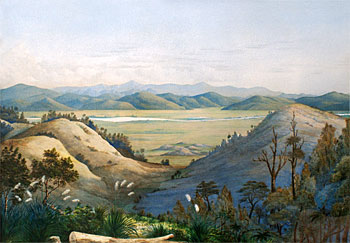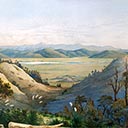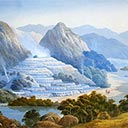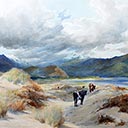View of the Mangatawhiri Swamp from Pokeno - Koheroa Pah in The Distance
41 x 60 cm
est. $35,000 - 45,000
Provenance: From the Estate of Sir James Fletcher 1914 - 2007
Among 19th century landscapists Alfred Sharpe (1836-1908) now holds a distinguished place, even though his works are individual in character and defy easy classification. He has sometimes been called a topographical painter despite the fact that his paintings are not primarily concerned with topography and usually also have an emphasis on colour, spatial effects and lighting, as we find in this example. While it is true that Sharpe sketched from nature and that his subjects are often identifiable that is not his central interest as a painter. In this case, for example, on the verso he has written a note as follows: View of Mangatawhiri Swamp from Pokeno - Koheroa Pah in the Distance. This allows us to locate the subject south of Auckland near the town of Pokeno but it could be argued that he has downplayed the recognisable landmarks of man or nature that preoccupy the topographical artist. Instead it is a typical sweep of country seen from an elevated viewpoint that attracts his attention foremost, with a light-filled space crossed by the meandering river as the focus of the middle distance. The pa is almost lost in the distance. His foreground, too, is filled with characteristic native trees and plants like the toi toi but has no distinctive building or landmark. Unlike the scenic painters such as John Gully who often chose iconic subjects like Mt Cook, Sharpe frequently avoids them in favour of less ostentatious material. Indeed, by the time Sharpe had reached his maturity as a painter in the 1870s and 1880s, the age of topographical painting was over and such work was done by photography.
Like the other late Victorian watercolourists Sharpe pushed the scale and ambition of the medium to its limits. He was competing with oil painters for attention and custom and to do so he had to achieve rich colour effects and dramatic contrasts of light and dark that would stand up in large art society exhibitions beside competing works submitted by other professionals.
We know that he gave great attention to developing his finished watercolours from outdoor sketches. In his 'Hints for Landscape Students in Watercolour' he talks of 'doing the contemplative' that is considering how to get the optimum effect from all the elements in the painting. For example, here he depicts the river as a ribbon of light in the distance shown to advantage by the darker, richly-coloured hills in the foreground. He has used body-colour to indicate highlights such as the gleam of sunlight on the river and the light tints of the feathery toi tois waving in the breeze. Any detail is confined to the foreground and does not detract from the breadth of his vision.
Sharpe painted exclusively in watercolour, a medium that was highly developed in Britain in the 19th century, especially by Turner. In works such as this, Sharpe produced some of the finest and most appealing images of 19th century New Zealand landscape. However, he deplored the destruction of the great native forests by loggers, and the felled tree in the foreground, stripped of its branches ready for milling, is a symbol of this exploitation of a natural resource with no thought for the future. Then as now conservation of natural resources is a primary consideration and Sharpe's painting helps remind us of this crucial concern. Such meanings add depth to his paintings and make them much more than topographical views. Michael Dunn
Text courtesy of Fletcher family





